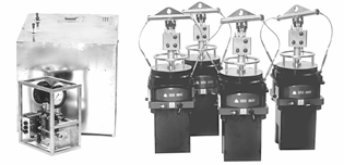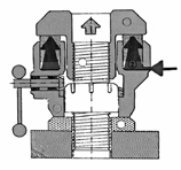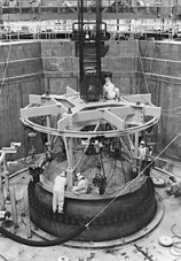Background
TENSOR™ stud tensioners provide utilities with an accurate, reliable, time-saving and cost-effective way to tension and detension reactor vessel studs.
The TENSOR™ tensioners were developed in Sweden and have been used extensively in Europe for 25 years. They are now being used in the U.S.
Stud tensioner units are used to replace existing tensioners, or are used in conjunction with a tensioner system upgrade, including:
- Increased numbers of tensioners/unit hoists/ controls
- Replacement head lift rig/carousel system
Description
The TENSOR™ stud tensioner is essentially a tubular hydraulic jack that elongates (preloads) a stud.
The tensioner puller sleeve is manually screwed onto the stud thread above the nut. A pump pressurizes a water-glycol hydraulic fluid that is then supplied to the underside of a floating, ring-shaped piston, forcing the puller sleeve upward. The reaction force by the collar pushes the washer and the flange downward while the stud is elastically elongated.
An external handle operates a gear mechanism that turns the nut down until it rests on the washer, seated on the flange surface. When the hydraulic pressure is released, the stud load, imparted by the tensioner, is restrained by the nut.

Four tensioners, a control console and a distribution manifold
During the installation of the tensioners, the weight of the puller sleeve is offset by the counterbalance system. This permits the puller sleeve to be threaded or unthreaded from the stud with minimal effort and without damaging the stud threads. An air hoist attached to the lift rig or carousel supports both the counterbalance system and the tensioner.The system pumping unit is housed in a cabinet that contains three air-driven hydraulic pumps, a fluid reservoir, an air regulator and control valves. The cabinet also contains the control panel, which consists of two operating air valves, a digital pressure readout and tensioner stroke indicator lamps.The TENSOR™ stud tensioners are part of the full complement of refueling enhancements available through Westinghouse, and include:
- The WETLIFT 2000™ system
- Rigid pole system
- Main steam line plugs
- Head lift rig and/or carousel
- Heavy load rigging
- Outage improvement studies
Benefits
Westinghouse’s field-proven TENSOR™ stud tensioners can significantly reduce the cost and outage time involved with stud tensioning. The simple, compact design also reduces maintenance costs while increasing tensioner reliability. By interfacing with the existing plant equipment, the tensioners save the cost of new hardware.
- Lower overall cost
- Interfaces with existing studs
- Can operate and be maintained easily
- Reduced outage time
- Exposure reduction
- Critical path time reduction
- Fewer personnel required (one per unit)
- Quick cycle time
- Reliability
- Field proven with more than 25 years of service
- Counterbalance system protects stud threads
- Simple and rugged design
- Parts and technical support are available through operations
Features
- Interfaces with existing equipment
- The TENSOR™ tensioners are designed to thread onto the existing studs. Modification or replacement of existing studs, nuts or washers is not required.
- The hoist supporting the tensioners attaches to the existing lifting system.
- These tensioners are available for all stud sizes.
- Compact design
- Each tensioner is 60 percent of the weight of comparable units.
- The small size and light weight make these tensioners easy to handle and store.
- The pump unit is integrated into the control console to simplify equipment setup and maintenance.
- Ease of maintenance
- The simple, rugged design results in units that are easy to maintain.
- The entire tensioner can be disassembled with a few hand tools.
- If required, spare parts and trained technicians are available through operations.
- Dependability
- In more than 25 years of service, the TENSOR™ has provided a consistently high level of service throughout the world.
- All major components have been selected for a 20-year service life.
- Accuracy
- The floating piston design provides nearly 100-percent efficiency on up to two degrees of reactor vessel flange rotation. The pressure readout system is accurate to ± 10 psi. With this accuracy, the trim passes can often be eliminated.
- Reduced outage time
- Tensioning/detensioning time reductions of 60 to 75 percent have been recorded. Cycle times as low as 4 minutes are achievable (with manual puller sleeve threading).
- Safety
- The pumping unit is powered by compressed air with a hydraulic system maximum operating pressure of 14,500 psi. The pressure is limited by the regulator and cannot exceed the design value.
- The hydraulic fluid is fire resistant, non-corrosive, non-toxic and highly resistant to aging and readily mixes with water.
Options

Tensioner schematic

U.S. plant outage showing six TENSOR™ tensioners, a rigid pole system and head lift rig/carousel
- Air drive
- An air drive system is available to automate the manual puller sleeve threading/unthreading operation.
- Stud cleaning equipment
- A hand-held stud cleaner and a totally enclosed, HEPA-filtered, automatic unit are available.
- Tensioning/detensioning program tuning
- A program to optimize the current tensioning/detensioning program can be designed.
- Pass reduction
- A program to reduce the number of tensioning passes can be designed.




